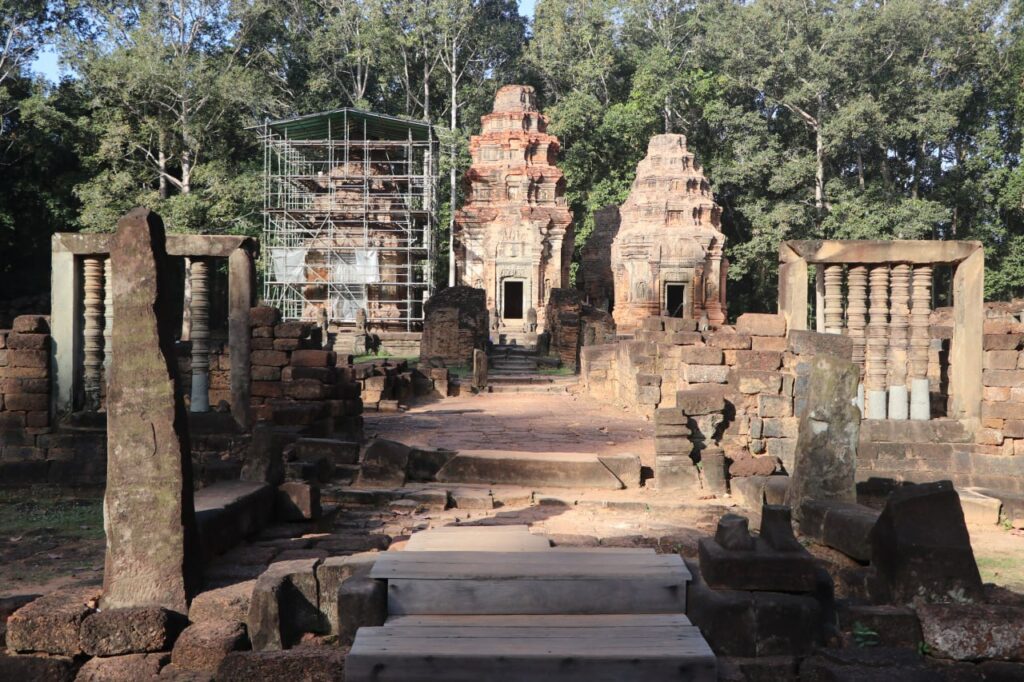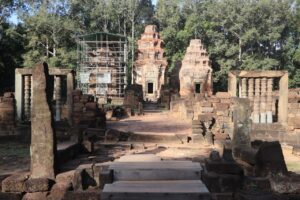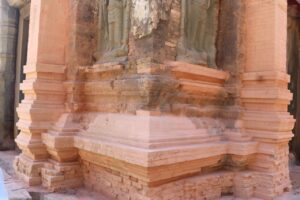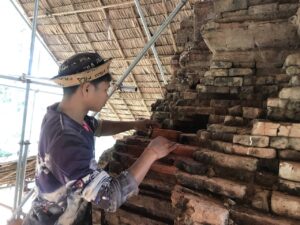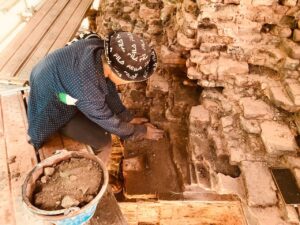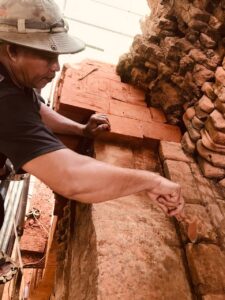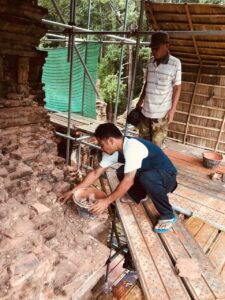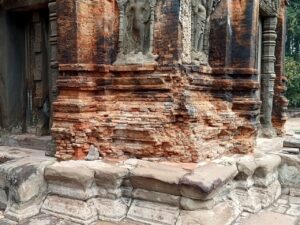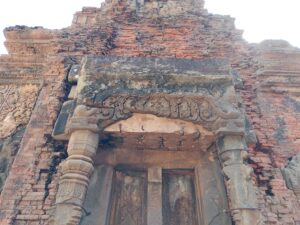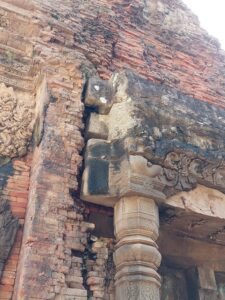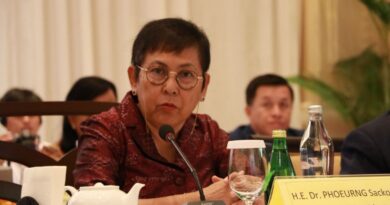តួប៉មប្រាសាទឥដ្ឋអាយុកាលជាង១ពាន់ឆ្នាំ នៅជ្រុងឦសាននៃប្រាសាទព្រះគោ ដែលធ្លាប់តែប្រឈមការខូចខាតកម្រិតខ្ពស់ បានប្រែក្លាយជាភាពរឹងមាំ និងល្អប្រសើរឡើងវិញហើយ បន្ទាប់ពីក្រុមអ្នកជំនាញនៃអាជ្ញាធរជាតិអប្សរាចំណាយពេលប្រហែល៧ខែ ដើម្បីជួយសង្គ្រោះរចនាសម្ពន្ធជាច្រើនផ្នែកមក។
លោក សារាយ គឹមហួល ប្រធានក្រុមអភិរក្សតំបន់រលួស នៃនាយកដ្ឋានអភិរក្សប្រាសាទ និងបុរាណវិទ្យារបស់អាជ្ញាធរជាតិអប្សរា ឱ្យដឹងថា ក្រុមការងារជួសជុលបានពង្រឹងរចនាសម្ពន្ធរបស់ប្រាសាទឥដ្ឋអាយុកាលជាង១ពាន់ឆ្នាំនេះទាំងមូលឡើងវិញ។ ជាមួយគ្នានេះ ក៏មានការជួសជុលផ្តែរ សសរផ្អោប ទ្វារបញ្ឆោតផ្នែកខាងលិច និងខាងជើង ព្រមទាំងដំបូល។
«នៅតាមជ្រុងនីមួយៗក៏បានពង្រឹងដោយប្រើលក្ខណៈបច្ចេកទេសបិទបាយអ ដើម្បីការពារកុំឱ្យទឹកដក់ក្នុងប្រាសាទ។ ក្រុមការងារក៏ប្រើបច្ចេកទេសនៃការជួសជុលនៅតាមរន្ធទឹក ដែលមានស្នាមប្រេះ ដោយបិទរន្ធទឹកជាថ្មី ដើម្បីកុំឱ្យទឹកហូរចូលទៅក្នុងប្រាសាទ»។
ប្រធានក្រុមអភិរក្សដដែលបានឱ្យដឹងទៀតថា ក្រុមការងារក៏បានរើឥដ្ឋដែលពុកផុយ ឬក៏ឥដ្ឋដែលអាចបង្កឱ្យមានគ្រោះថ្នាក់ចេញ ហើយដាក់ឥដ្ឋថ្មីមួយចំនួនមកជំនួសនៅផ្នែកខាងក្នុង ហើយនៅផ្នែកខាងក្រៅ គឺប្រើឥដ្ឋចាស់ ដើម្បីបង្កើនភាពមាំនៃតួប្រាសាទ ព្រមទាំងរក្សាសោភ័ណភាពបែបបុរាណផង។
តួប៉មនៅជ្រុងឦសាននៃប្រាសាទព្រះគោ ទទួលរងការខូចខាតជាចម្បងគឺ បណ្ដាលមកពីបញ្ហាទឹកភ្លៀងហូរចូលទៅក្នុងតួប្រាសាទធ្វើឱ្យមានប្រតិកម្មជាមួយអាចម៍ប្រចៀវបង្កើតទៅជាជាតិអាស៊ីតម្យ៉ាង។ កត្តាអាយុកាលចំណាស់របស់សំណង់ និងអាកាសធាតុ ក៏បានរួមចំណែកធ្វើឱ្យសំណង់ប្រាសាទខូចខាត ដូចជាធ្វើឱ្យឥដ្ឋនៅផ្នែកខាងក្នុងជាច្រើនមានពណ៌ខ្មៅហើយពុកផុយ ដែលទឹកភ្លៀងអាចហូរចូលបានយ៉ាងងាយធ្វើឱ្យរុក្ខជាតិជាច្រើនដុះលូតលាស់ផងដែរ។ ក្រុមអ្នកជំនាញនៃអាជ្ញាធរជាតិអប្សរា បានចាប់ផ្ដើមជួសជុលតួប៉មប្រាសាទឥដ្ឋនៅជ្រុងឦសាន នៃប្រាសាទព្រះគោនេះ តាំងតែពីខែឧសភា ឆ្នាំ២០២៤ ហើយបច្ចុប្បន្នការងារដ៏ពិបាកនេះ បានទទួលជោគជ័យ និងបញ្ចប់ជាស្ថាពរ៕
អត្ថបទ៖ ឆាយ ផាន់នី
រូបភាព៖ លោក យី សុថា,ភោគ ជា និងលោក សារាយ គឹមហួល
The APSARA National Authority has successfully completed a restoration project for the northeast tower of the Preah Ko Temple, which had suffered significant damage over the years. The restoration team dedicated approximately seven months to reinforcing various aspects of the structure.
Mr. Saray Kimhual, who led the restoration efforts, reported that the entire structure of the tower was strengthened. Key areas such as the foundation, pillars, and both the western and northern doors were repaired, along with the roof. The team employed mortar sealing techniques at each corner to prevent water infiltration, which has been a major issue for the temple. They also addressed cracks in water holes by resealing them to stop further water flow into the temple.
In addition to these repairs, the team removed deteriorating bricks that posed safety risks and replaced them with new bricks internally, while using older bricks externally to preserve the temple’s traditional aesthetic and enhance its strength.
The damage to the northeast tower was primarily caused by rainwater interacting with bat droppings, creating acidic conditions that accelerated deterioration. The age of the building and environmental factors further contributed to the decay, resulting in many internal bricks turning black and rotting, which facilitated plant growth within the structure.
Experts from the APSARA National Authority began their restoration work in May 2024, and after overcoming various challenges, they have now completed the project.
Article: Chhay Phanny
Photos: Yi Sotha, Phouk Chea, and Saray Kimhual
Article Translator: Net Phirun

